Opinion & Analysis
Callaway R&D Director on the XR irons, 360 Face Cup
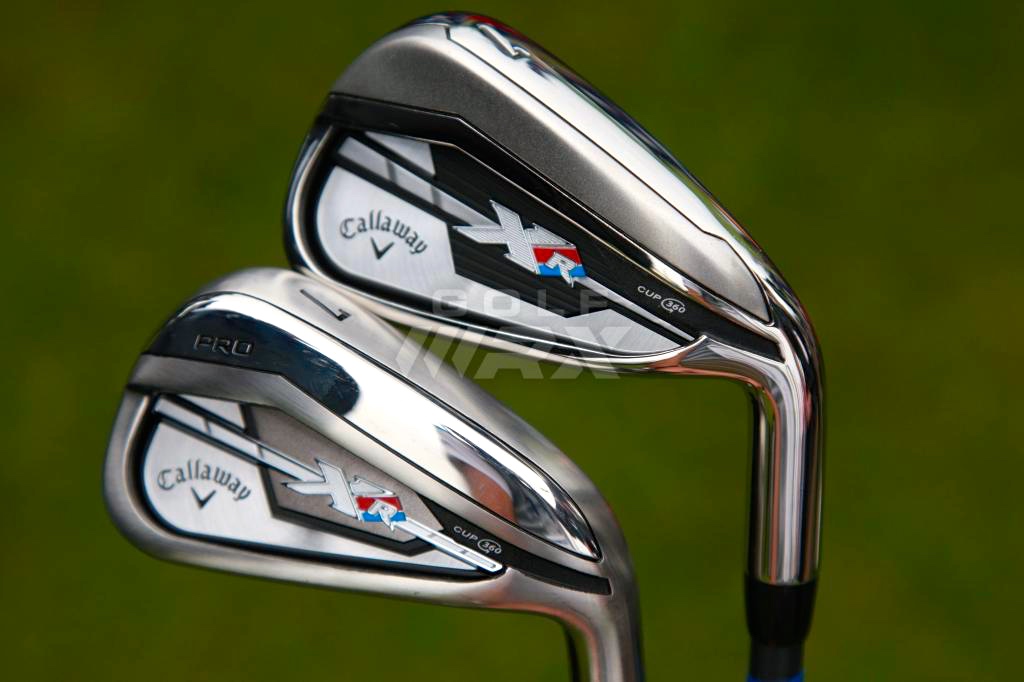
Scott Manwaring, Callaway’s director of R&D for irons, hybrids and wedges, has been with the company for nearly two decades, and he’s worked in club design since the mid-2000s. He’s seen a lot in his time at the Carlsbad-based company, which under the direction of CEO Chip Brewer, is putting product front-and-center, according to the R&D specialist.
The company’s latest product to stand front and center: Callaway’s XR and XR Pro irons with Callaway’s Face Cup 360 technology.
Manwaring, who graduated from Brigham Young University with a degree in mechanical engineering, said he was incredibly proud of the new XR and XR Pro irons, which were the focus of our conversation.
Note: Topics in bold with Manwaring’s replies beneath
Callaway’s primary focus, how it influences product
The broad umbrella changed with Chip coming here. He said, “Be proud of the product that you’re creating.” Before, it was a lot more nuanced and complicated.
Chip is driven on the product front. Callaway spends more than $30 million per year in R&D, so that philosophy comes from Chip himself: Be proud of it. Drive every last detail, do it as quickly as possible.
That has to drive its way into every category. With the X Hot fairway wood, we took it all the way to the finish line. The next year, we said, “Let’s get the hybrids.” This was the first year that that mantra really hit irons. I obviously had a lot going on, and we’re trying to change a lot of products, but you can only turn a boat so fast; this is the first year we said, “Let’s really drive it home in irons.”
Developing the XR Irons
On the Apex iron, where your COGs are a lot higher, it’s easier to fix that one. When you get down to the $799 category, you have to think a lot harder about every nickel you spend and why you spend it to give the consumer the best value and also make a product you’re proud of. That just takes a little more time and effort.
Just to give you a perspective of what a pain in the a** this iron was to make: We did eight prototyping iterations with the suppliers alone — You know, get the part back, test it, change it. That is at least five or six more than we would normally do. That doesn’t even count internally. We did about four or five…using our own machines.
Addressing concerns about hot spots
We were aware of the complaint. From our position, a common complaint is just an opportunity to do something completely different and completely out of the box.
You have this opportunity with Chip coming on board and saying, “Do something different…do something that you’re proud of. Do something that’s harder.”
You have this great opportunity to break the problem up and really dig into every detail…and think in different ways to tackle all those items.
An overview of Cup 360 technology
Talking about the 360 cup face: By separating an iron into two pieces, you inherently increase the complexity and the cost. And when you weld two similar materials, it’s kind of counter-intuitive. But we needed to cast the face independently because we needed control of every…point on the back of the face.
We needed to control the thickness at every location to avoid changes in thickness that create hotspots.
You’re seeing a lot of companies take the easier solution and not keep the CG in the optimal spot, because they know they need to control face. And you see them taking the simple solution and not worrying about the thickness.
You’re still using the same FEA tools and all the stuff you’ve used in the past, but when you do things like this…when you’re trying to get the distance, plus maintain consistency, your material properties become way more critical. So all your analysis tools start to struggle. You pick up failure modes that are somewhat unexpected.
I think one aspect that’s kind of lost on everybody here is when we did the face cups on the fairway woods and the hybrids, you had this eggshell principle going on where it was a closed-back system…it was naturally stronger and thicker.
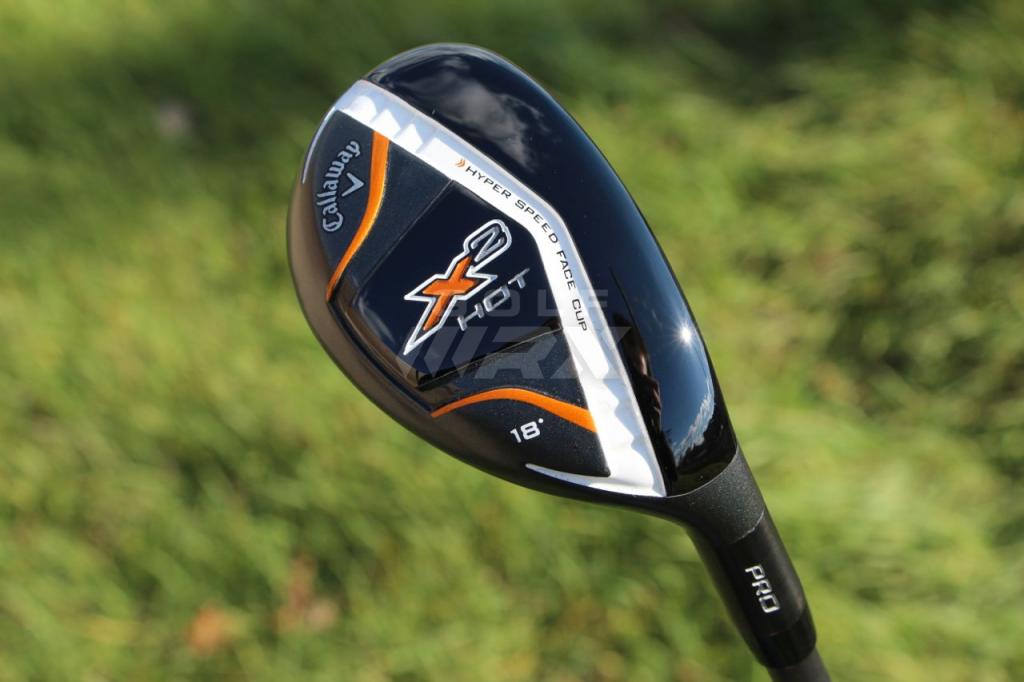
Callaway’s X2 Hot and X2 Hot Hybrids (2014) brought the company’s face cup technology to hybrids, giving them the 455 carpenter steel faces used on the 2013 X Hot fairway woods.
On a cavity back iron, when you open up the back of that iron, you’re now on a way more flexible system. Dealing with your durability requirements and your strength requirements is a lot more complicated. And when you overlay the cost…you’ve got a real problem.
The face cup, it’s just as critical as the body. When you separate the face cup…it allows you to minimize your hotspots, especially when you cast it, because then you don’t have any machining marks, you’re not dealing with forging or some of the inherent problems that come there with draft analysis and some of the complexity there…and the cost.
The COR testing becomes obvious. You put that cup face on there and your COR gains across the face are just incredible. So the face cup is critical, but then you’ve got to move to the body. The second you…pull the mass away from the face…your center of gravity just climbs immediately…and then you’ve washed out all the gains. So, step two is finding a body design that when all that energy is transferred off the face, it doesn’t die.
The XR Pro
On the Pro, we wanted to not offend PGA Tour players with the thicker top line. Getting that just right—where it still has the durability and still has the ball speed and still has the COR numbers we were interested in, and it still has the CG and can carry the load—it was a challenge.
Your thickness on that top line: As you get that face to transfer energy more efficiently to the ball and ultimately also to the body…it becomes a trampoline. And if you wanted the metal rims around the trampoline to be thinner, the person jumping on it is still transferring the same load, and if you start thinning those rims down too much, they just give out.
So, the Pro iron is an incredible club…some better players hit the Pro farther than they do the standard [XR]. When I was looking at the COR data, I originally thought it was just the offset and they were able to swing at it more aggressively. But…we did a damn good job…it’s incredibly efficient for its face area.
A walkthrough of Callaway’s 2015 irons
With Big Bertha, it’s just “how can we help you?” We’re doing everything we can to help you enjoy the round of golf. We’re going to help you get the ball to fly far. You’re going to have a lot of hybrids in your bag.
With the XR, we intentionally designed stuff in there to help the average golfer that we knew the better player would snub their nose at. But with the XR Pro, Chip said: “You’re not allowed to skimp on the technology.”
In creating the XR Pro, we took everything we learned from the XR—because we did that first—and applied those lessons to the XR Pro in a shape that we knew wouldn’t offend, and it ended up doing really, really well.
The XR is for the center-of-the-green player. The player who isn’t going to work the ball, who just wants to check the yardage and hit it. But in order to help that player along, it requires a certain offset, a certain top line thickness, a sole width to help with turf interaction, a little more MOI. The XR is for that weekend guy that’s out there quite a bit.
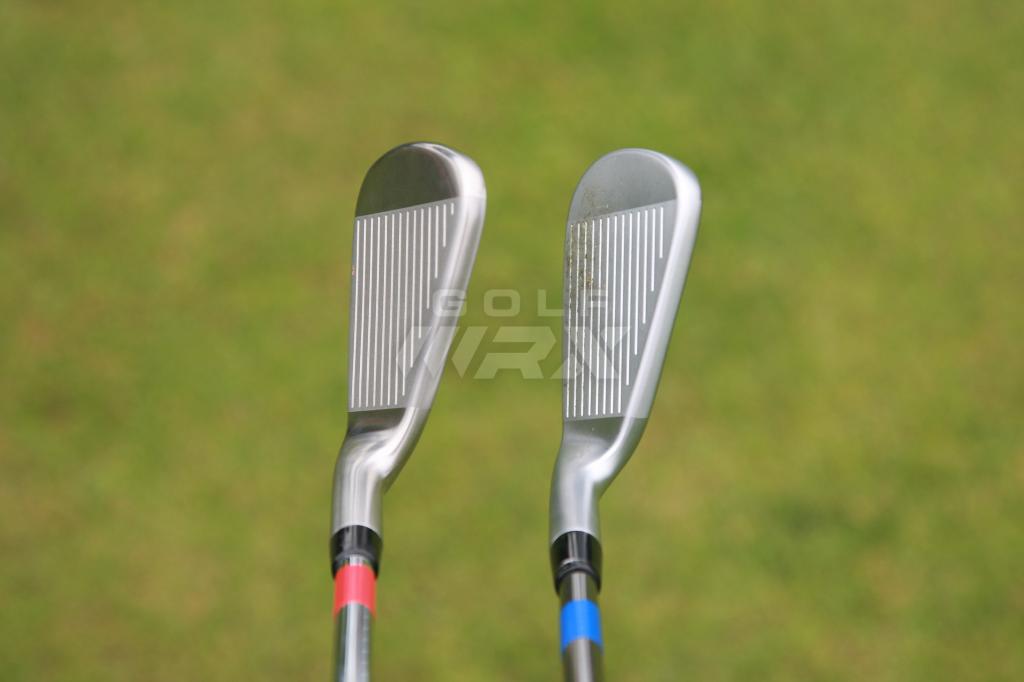
At Address: Callaway’s XR Pro (left) and Apex irons.
The XR Pro…was really going after someone who really likes his Apex irons but would like a little more control. We kind of kept the offset; we narrowed the top line back down. We brought the sole width back down…and this is a guy we see wanting to be a pin-seeker, wanting to really go after it…he’s going to be disappointed if he didn’t pull the shot off. So the MOI is a little lower, the top line is a little thinner. The Pro is for someone who I think is truly passionate about their game.
- LIKE112
- LEGIT10
- WOW9
- LOL4
- IDHT6
- FLOP10
- OB7
- SHANK14
19th Hole
Vincenzi’s 2024 Zurich Classic of New Orleans betting preview

The PGA TOUR heads to New Orleans to play the 2023 Zurich Classic of New Orleans. In a welcome change from the usual stroke play, the Zurich Classic is a team event. On Thursday and Saturday, the teams play best ball, and on Friday and Sunday the teams play alternate shot.
TPC Louisiana is a par 72 that measures 7,425 yards. The course features some short par 4s and plenty of water and bunkers, which makes for a lot of exciting risk/reward scenarios for competitors. Pete Dye designed the course in 2004 specifically for the Zurich Classic, although the event didn’t make its debut until 2007 because of Hurricane Katrina.
Coming off of the Masters and a signature event in consecutive weeks, the field this week is a step down, and understandably so. Many of the world’s top players will be using this time to rest after a busy stretch.
However, there are some interesting teams this season with some stars making surprise appearances in the team event. Some notable teams include Patrick Cantlay and Xander Schauffele, Rory McIlroy and Shane Lowry, Collin Morikawa and Kurt Kitayama, Will Zalatoris and Sahith Theegala as well as a few Canadian teams, Nick Taylor and Adam Hadwin and Taylor Pendrith and Corey Conners.
Past Winners at TPC Louisiana
- 2023: Riley/Hardy (-30)
- 2022: Cantlay/Schauffele (-29)
- 2021: Leishman/Smith (-20)
- 2019: Palmer/Rahm (-26)
- 2018: Horschel/Piercy (-22)
- 2017: Blixt/Smith (-27)
2024 Zurich Classic of New Orleans Picks
Tom Hoge/Maverick McNealy +2500 (DraftKings)
Tom Hoge is coming off of a solid T18 finish at the RBC Heritage and finished T13 at last year’s Zurich Classic alongside Harris English.
This season, Hoge is having one of his best years on Tour in terms of Strokes Gained: Approach. In his last 24 rounds, the only player to top him on the category is Scottie Scheffler. Hoge has been solid on Pete Dye designs, ranking 28th in the field over his past 36 rounds.
McNealy is also having a solid season. He’s finished T6 at the Waste Management Phoenix Open and T9 at the PLAYERS Championship. He recently started working with world renowned swing coach, Butch Harmon, and its seemingly paid dividends in 2024.
Keith Mitchell/Joel Dahmen +4000 (DraftKings)
Keith Mitchell is having a fantastic season, finishing in the top-20 of five of his past seven starts on Tour. Most recently, Mitchell finished T14 at the Valero Texas Open and gained a whopping 6.0 strokes off the tee. He finished 6th at last year’s Zurich Classic.
Joel Dahmen is having a resurgent year and has been dialed in with his irons. He also has a T11 finish at the PLAYERS Championship at TPC Sawgrass which is another Pete Dye track. With Mitchell’s length and Dahmen’s ability to put it close with his short irons, the Mitchell/Dahmen combination will be dangerous this week.
Taylor Moore/Matt NeSmith +6500 (DraftKings)
Taylor Moore has quickly developed into one of the more consistent players on Tour. He’s finished in the top-20 in three of his past four starts, including a very impressive showing at The Masters, finishing T20. He’s also finished T4 at this event in consecutive seasons alongside Matt NeSmith.
NeSmith isn’t having a great 2024, but has seemed to elevate his game in this format. He finished T26 at Pete Dye’s TPC Sawgrass, which gives the 30-year-old something to build off of. NeSmith is also a great putter on Bermudagrass, which could help elevate Moore’s ball striking prowess.
- LIKE7
- LEGIT3
- WOW1
- LOL1
- IDHT0
- FLOP3
- OB1
- SHANK1
19th Hole
Vincenzi’s 2024 LIV Adelaide betting preview: Cam Smith ready for big week down under

After having four of the top twelve players on the leaderboard at The Masters, LIV Golf is set for their fifth event of the season: LIV Adelaide.
For both LIV fans and golf fans in Australia, LIV Adelaide is one of the most anticipated events of the year. With 35,000 people expected to attend each day of the tournament, the Grange Golf Club will be crawling with fans who are passionate about the sport of golf. The 12th hole, better known as “the watering hole”, is sure to have the rowdiest of the fans cheering after a long day of drinking some Leishman Lager.
The Grange Golf Club is a par-72 that measures 6,946 yards. The course features minimal resistance, as golfers went extremely low last season. In 2023, Talor Gooch shot consecutive rounds of 62 on Thursday and Friday, giving himself a gigantic cushion heading into championship Sunday. Things got tight for a while, but in the end, the Oklahoma State product was able to hold off The Crushers’ Anirban Lahiri for a three-shot victory.
The Four Aces won the team competition with the Range Goats finishing second.
*All Images Courtesy of LIV Golf*
Past Winners at LIV Adelaide
- 2023: Talor Gooch (-19)
Stat Leaders Through LIV Miami
Green in Regulation
- Richard Bland
- Jon Rahm
- Paul Casey
Fairways Hit
- Abraham Ancer
- Graeme McDowell
- Henrik Stenson
Driving Distance
- Bryson DeChambeau
- Joaquin Niemann
- Dean Burmester
Putting
- Cameron Smith
- Louis Oosthuizen
- Matt Jones
2024 LIV Adelaide Picks
Cameron Smith +1400 (DraftKings)
When I pulled up the odds for LIV Adelaide, I was more than a little surprised to see multiple golfers listed ahead of Cameron Smith on the betting board. A few starts ago, Cam finished runner-up at LIV Hong Kong, which is a golf course that absolutely suits his eye. Augusta National in another course that Smith could roll out of bed and finish in the top-ten at, and he did so two weeks ago at The Masters, finishing T6.
At Augusta, he gained strokes on the field on approach, off the tee (slightly), and of course, around the green and putting. Smith able to get in the mix at a major championship despite coming into the week feeling under the weather tells me that his game is once again rounding into form.
The Grange Golf Club is another course that undoubtedly suits the Australian. Smith is obviously incredibly comfortable playing in front of the Aussie faithful and has won three Australian PGA Championship’s. The course is very short and will allow Smith to play conservative off the tee, mitigating his most glaring weakness. With birdies available all over the golf course, there’s a chance the event turns into a putting contest, and there’s no one on the planet I’d rather have in one of those than Cam Smith.

Louis Oosthuizen +2200 (DraftKings)
Louis Oosthuizen has simply been one of the best players on LIV in the 2024 seas0n. The South African has finished in the top-10 on the LIV leaderboard in three of his five starts, with his best coming in Jeddah, where he finished T2. Perhaps more impressively, Oosthuizen finished T7 at LIV Miami, which took place at Doral’s “Blue Monster”, an absolutely massive golf course. Given that Louis is on the shorter side in terms of distance off the tee, his ability to play well in Miami shows how dialed he is with the irons this season.
In addition to the LIV finishes, Oosthuizen won back-to-back starts on the DP World Tour in December at the Alfred Dunhill Championship and the Mauritus Open. He also finished runner-up at the end of February in the International Series Oman. The 41-year-old has been one of the most consistent performers of 2024, regardless of tour.
For the season, Louis ranks 4th on LIV in birdies made, T9 in fairways hit and first in putting. He ranks 32nd in driving distance, but that won’t be an issue at this short course. Last season, he finished T11 at the event, but was in decent position going into the final round but fell back after shooting 70 while the rest of the field went low. This season, Oosthuizen comes into the event in peak form, and the course should be a perfect fit for his smooth swing and hot putter this week.

- LIKE12
- LEGIT3
- WOW1
- LOL1
- IDHT0
- FLOP1
- OB1
- SHANK1
Opinion & Analysis
The Wedge Guy: What really makes a wedge work? Part 1

Of all the clubs in our bags, wedges are almost always the simplest in construction and, therefore, the easiest to analyze what might make one work differently from another if you know what to look for.
Wedges are a lot less mysterious than drivers, of course, as the major brands are working with a lot of “pixie dust” inside these modern marvels. That’s carrying over more to irons now, with so many new models featuring internal multi-material technologies, and almost all of them having a “badge” or insert in the back to allow more complex graphics while hiding the actual distribution of mass.
But when it comes to wedges, most on the market today are still single pieces of molded steel, either cast or forged into that shape. So, if you look closely at where the mass is distributed, it’s pretty clear how that wedge is going to perform.
To start, because of their wider soles, the majority of the mass of almost any wedge is along the bottom third of the clubhead. So, the best wedge shots are always those hit between the 2nd and 5th grooves so that more mass is directly behind that impact. Elite tour professionals practice incessantly to learn to do that consistently, wearing out a spot about the size of a penny right there. If impact moves higher than that, the face is dramatically thinner, so smash factor is compromised significantly, which reduces the overall distance the ball will fly.
Every one of us, tour players included, knows that maddening shot that we feel a bit high on the face and it doesn’t go anywhere, it’s not your fault.
If your wedges show a wear pattern the size of a silver dollar, and centered above the 3rd or 4th groove, you are not getting anywhere near the same performance from shot to shot. Robot testing proves impact even two to three grooves higher in the face can cause distance loss of up to 35 to 55 feet with modern ‘tour design’ wedges.
In addition, as impact moves above the center of mass, the golf club principle of gear effect causes the ball to fly higher with less spin. Think of modern drivers for a minute. The “holy grail” of driving is high launch and low spin, and the driver engineers are pulling out all stops to get the mass as low in the clubhead as possible to optimize this combination.
Where is all the mass in your wedges? Low. So, disregarding the higher lofts, wedges “want” to launch the ball high with low spin – exactly the opposite of what good wedge play requires penetrating ball flight with high spin.
While almost all major brand wedges have begun putting a tiny bit more thickness in the top portion of the clubhead, conventional and modern ‘tour design’ wedges perform pretty much like they always have. Elite players learn to hit those crisp, spinny penetrating wedge shots by spending lots of practice time learning to consistently make contact low in the face.
So, what about grooves and face texture?
Grooves on any club can only do so much, and no one has any material advantage here. The USGA tightly defines what we manufacturers can do with grooves and face texture, and modern manufacturing techniques allow all of us to push those limits ever closer. And we all do. End of story.
Then there’s the topic of bounce and grinds, the most complex and confusing part of the wedge formula. Many top brands offer a complex array of sole configurations, all of them admittedly specialized to a particular kind of lie or turf conditions, and/or a particular divot pattern.
But if you don’t play the same turf all the time, and make the same size divot on every swing, how would you ever figure this out?
The only way is to take any wedge you are considering and play it a few rounds, hitting all the shots you face and observing the results. There’s simply no other way.
So, hopefully this will inspire a lively conversation in our comments section, and I’ll chime in to answer any questions you might have.
And next week, I’ll dive into the rest of the wedge formula. Yes, shafts, grips and specifications are essential, too.
- LIKE32
- LEGIT7
- WOW1
- LOL1
- IDHT2
- FLOP3
- OB1
- SHANK3
-

 19th Hole2 weeks ago
19th Hole2 weeks agoDave Portnoy places monstrous outright bet for the 2024 Masters
-

 19th Hole2 weeks ago
19th Hole2 weeks agoTiger Woods arrives at 2024 Masters equipped with a putter that may surprise you
-

 19th Hole2 days ago
19th Hole2 days agoJustin Thomas on the equipment choice of Scottie Scheffler that he thinks is ‘weird’
-

 19th Hole2 days ago
19th Hole2 days ago‘Absolutely crazy’ – Major champ lays into Patrick Cantlay over his decision on final hole of RBC Heritage
-

 19th Hole3 weeks ago
19th Hole3 weeks agoReport: Tiger Woods has ‘eliminated sex’ in preparation for the 2024 Masters
-

 19th Hole1 week ago
19th Hole1 week agoTwo star names reportedly blanked Jon Rahm all week at the Masters
-

 19th Hole1 week ago
19th Hole1 week agoReport: LIV Golf identifies latest star name they hope to sign to breakaway tour
-

 19th Hole1 week ago
19th Hole1 week agoNeal Shipley presser ends in awkward fashion after reporter claims Tiger handed him note on 8th fairway

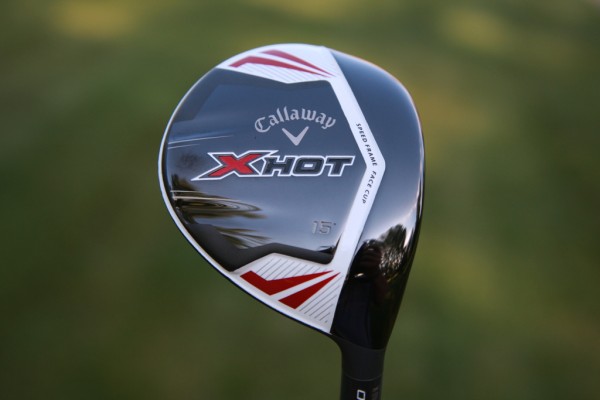
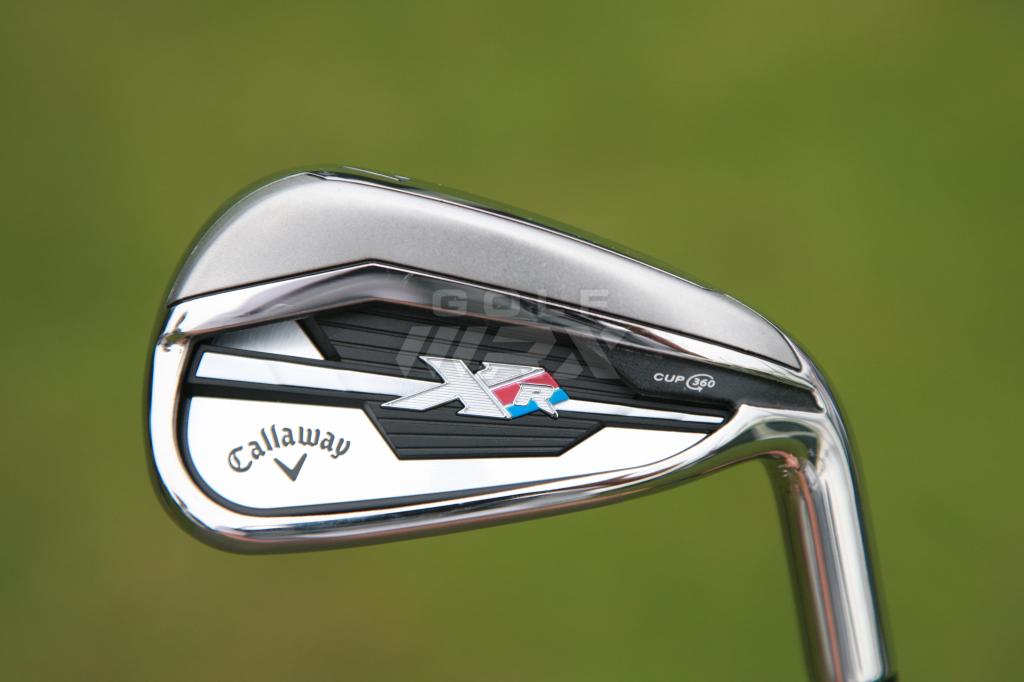
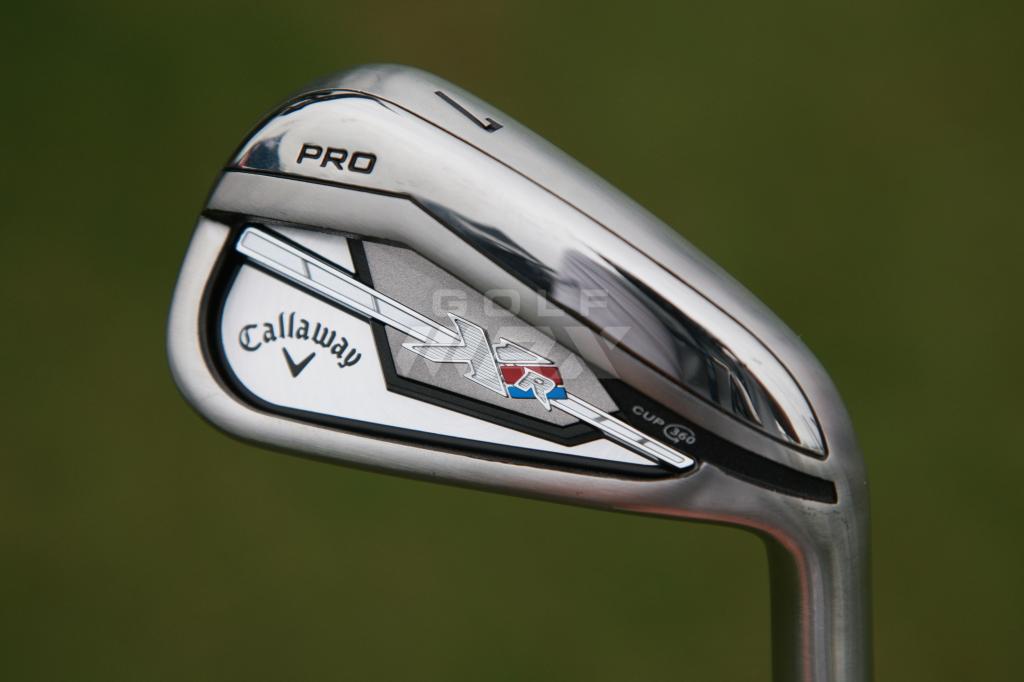
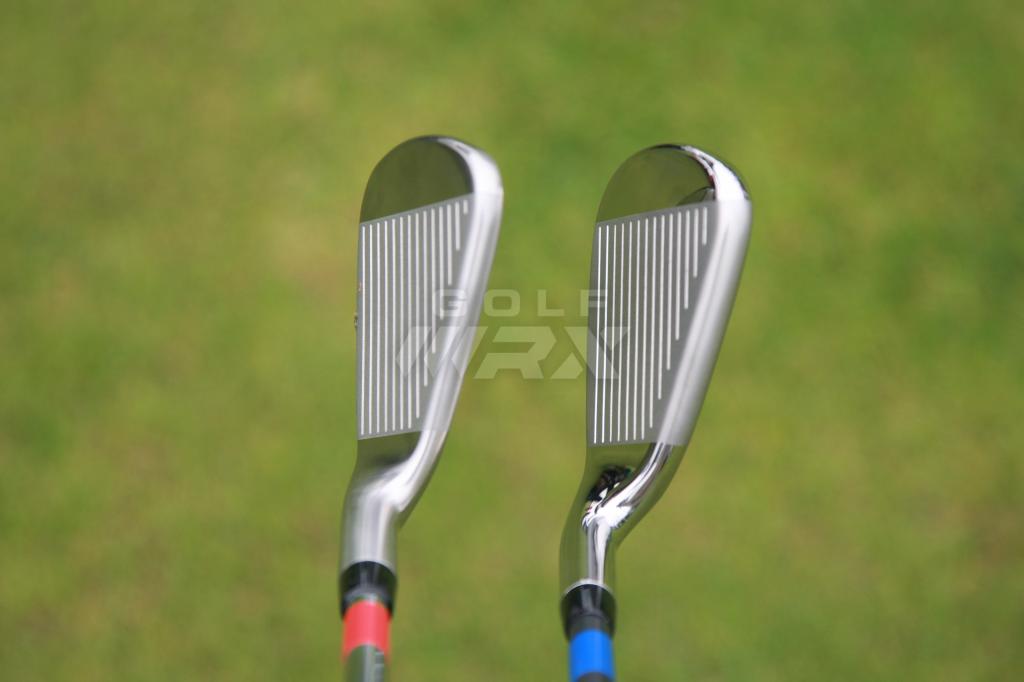
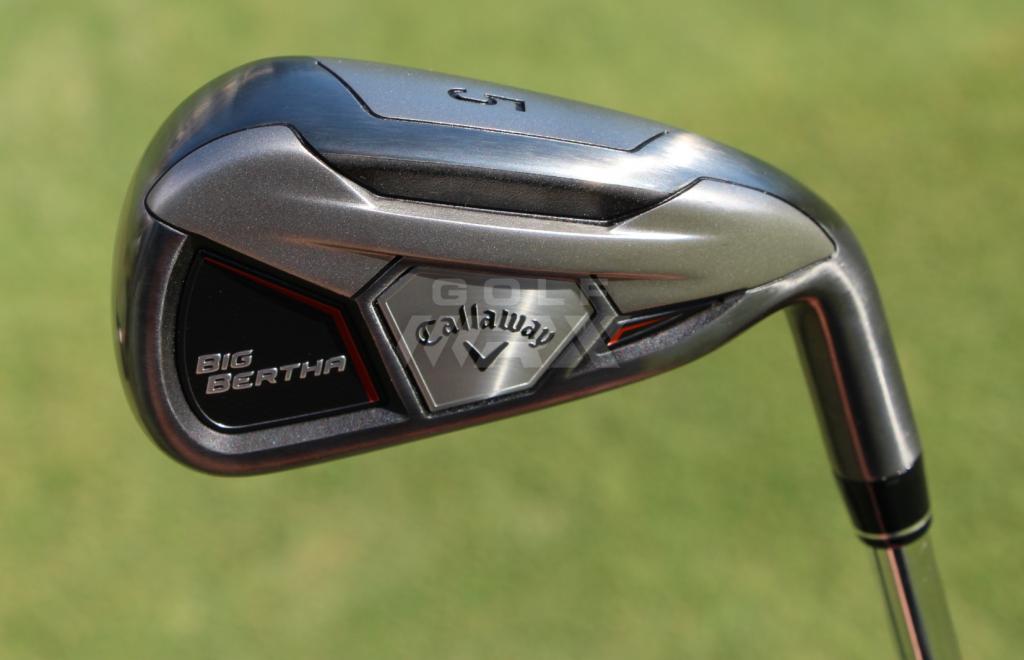














t golf
Mar 3, 2015 at 8:30 am
How much different are these than something like the speedblades? Those have little off set for a GI and pound the ball. Straight too.
Vito
Mar 1, 2015 at 1:19 pm
Just ordered my XR Pro and Apex MB combo set. Now if the snow will just allow me to use them…
Jeff
Feb 24, 2015 at 5:24 pm
Oh great, now I have to throw out my Apex Pros. The marketing on these new iron sets leaves the guys who bought last year’s sales pitch hung out to dry. Basically, last year’s 1200 dollar set is obsolete, because, you know, face cups and stuff. High CT, face cups, progressive this, channel slot that. I hope the garbage man takes my Apex Pros without charging me extra.
killerbgolfer
Feb 24, 2015 at 10:16 pm
I hope not, i just got the Apex forged! I don’t see these really threatening the forged offerings. Until there’s new forged offerings…
Ol deadeye
Feb 25, 2015 at 11:29 am
Well, keeping in mind that the USGA limits the COR of all club faces, I took my 20 yr old daughter(12 handicap) to a big box store. We compared her shots with her Ping G20 seven iron (steel R shaft) and both Taylormade RSi 1 and Callaway XR seven irons. Distance increase? About one or two yards with either club. With both steel or graphite shaft. She preferred the steel shafts. These were 85 grams and Ping steel is about 100. She preferred the impact feel and swing weight of the Taylormade. Enough there to replace her clubs? Not in our opinions.
Ol deadeye
Feb 23, 2015 at 2:04 pm
It would seem that the players most interested in distance with irons would be the better women players. Not granny who retired and took up golf at 65. Younger women who hit an eight iron 110 yards. If the shaft is about the same length but flies the ball ten yards further that would be a game changer.
Roosterredneck
Feb 23, 2015 at 1:12 pm
The 360 club design is not new. Macgregor did this years ago.Yes the thick top line and off set is excessive for me .. Buy a Macgregor model it should be much cheaper.
Teaj
Feb 20, 2015 at 3:37 pm
These things get out there, stronger then your traditional lofts yes but if your looking for a little extra distance with forgiveness and less offset these might fit the bill. They go a little to far for me as I don’t really need to hit my clubs farther but the forgiveness with less offset is something to think about for players not playing as much as they used to but still don’t need offset. Go try it before you knock it, for the right person these would be a great club.
Person
Feb 20, 2015 at 11:52 am
What throws me off about those irons is how round the topline looks from address. Also yes they look just a little too thick for my tastes.
Vincent
Feb 20, 2015 at 10:45 am
Callaway could forget the “Big Bertha” trademark. This is a cannon built and used by the German army against Belgian and French soldiers and fortresses during the First World War. What could we think about a golf club named Kalashnikov?
graymulligan
Feb 22, 2015 at 7:26 pm
If you asked most folks at this point, especially golfers, they would equate the Big Bertha name to the clubs, and not the cannon. It might be a couple decades too late to have this conversation.
gwillis7
Feb 20, 2015 at 10:36 am
Very interesting article. Haven’t had a ton of Callaway gear in the past, but did have the x-hot driver and that thing was a beast. Last couple years they def have made huge strides in woods
Dave S
Feb 20, 2015 at 9:15 am
This probably isn’t the forum to post this, but looking at the top-line pics of these irons, it really struck me. I’ve always struggled with the large off-set that typically exists in a true GI iron. My natural shot shape with irons is right to left, with my miss usually being a hook. I’m not a great player by any stretch (14 hcp) and I’ve been playing the Adams CMBs for three seasons now. I’ve always been a naturally good athlete, but I really don’t play enough to get great at golf (every other weekend in the spring and summer), so I think GI irons could help. BUT, they all have that huge off-set, which with my natural in-to-out swing path, would likely exacerbate my hook. I guess these OEMs have to make a product that fits the majority of mid-high handicappers and their miss is usually left to right… I’m kind of in a weird spot.
Jeff
Feb 24, 2015 at 5:19 pm
Dave, players cavity backs. Less offset, more forgiveness.
CHRIS
Feb 20, 2015 at 8:40 am
Looks like tennis rackets to me, both of them. I just cannot bear to look down and see a topline like that.
Rich
Feb 20, 2015 at 9:11 am
Keep playing your blades mate. I’ll take your money with a set of XR pros thanks.
Mike
Feb 20, 2015 at 9:24 am
Rich you know if you don’t use blades you’re a loser! 🙂 Which I guess I am since I just took delivery of my XR Pros.
Rich
Feb 20, 2015 at 5:14 pm
Yep, I know what you mean Mike. Happy to be a loser. Can’t wait to try the XR pro’s, they look pretty good to me. Happy for all the help I can get these days.
Philip
Feb 20, 2015 at 2:29 pm
Maybe, maybe not – if the guy doesn’t like the look than so what? By the way, I don’t like them too, but whether one plays blades or XR Pros is irrelevant to whether they’ll beat someone else in a match. I’ve played both with players using blades and players using clubs like the XP Pros and the deciding factor of their game has NOTHING to do with what type of iron they play, but whether they know their true yardages and whether they know their weaknesses and play accordingly.
Rich
Feb 20, 2015 at 5:08 pm
Easy there tiger. Just poking a bit of fun. I love blades and have several sets but don’t play them much anymore because my game is not what it used to be. All power to those that can.
XR is King
Feb 19, 2015 at 10:59 pm
The XR irons are going to blow everybody away!!!!! Awesome!!!!
Cyd
Feb 19, 2015 at 10:30 pm
Hit the Pro model further???? Difference in lofts maybe?
Cyd
Feb 19, 2015 at 10:29 pm
Hit the Pro further???? Difference in lofts?
I have a new set of irons for the masses. Guaranteed to add 15 more yards. Of course the lofts are 2* stronger than the previous model so now your 7 Iron is what used to be a 5 iron, the PW is what used to be an 8 iron, so on and so forth.
But by golly I can hit a 8 Iron 190 or more and Hogan or Nicklaus could never do that.
Tom
Feb 20, 2015 at 4:17 pm
Pro is +1* on lofts (weaker) and shorter in length in the long irons (3-6) than the plain XR also lie angles are different between the models.
And yes lofts are stronger than in the 60’s or 70’s but when I can get a 7i launching at over 20* why should I care? As to added length, hey 4 wedges is fine in the bag. (Really only 2 or 3 using old lofts.) So long as my misses are closer in results to solid hits.
BTW: Jack could do that. He choose not to most of the time. I remember him being in trouble at Firestone once and hitting a VERY long 8i. But then that was with far worse equipment esp. balls than today!
Steve
Feb 19, 2015 at 7:33 pm
Xhot line with different colors
LMB
Feb 19, 2015 at 10:24 pm
I’d say that was true for X2 Hot irons but these have legit tech updates.
Tom
Feb 19, 2015 at 7:11 pm
Both the XR and XR Pro swing very nice. (With proper fit.) I get my XR Pro irons next week, my pro e-mailed me they got in and would be available at my lesson on Tue. I’ve been hitting the demo iron and LOVE how it feels/swings, the feed back, and how consistent yardage is between center and off center hits. Callaway was not on my radar when I went to get new irons but these just blew me away! 🙂
LMB
Feb 19, 2015 at 6:36 pm
Sounds like they made the XR first, and then figured out how to make a better version of it when they did the XR Pro…